情态动词 have 过去分词句型的用法
- 格式:doc
- 大小:39.00 KB
- 文档页数:3
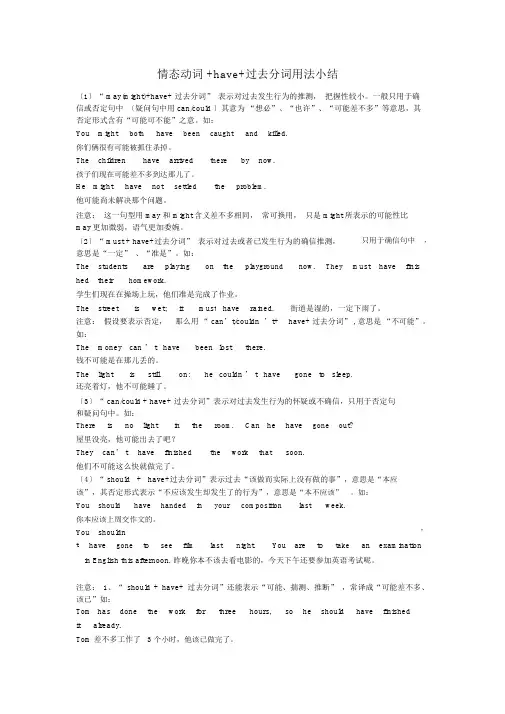
情态动词 +have+过去分词用法小结〔1〕“ may(might)+have+ 过去分词” 表示对过去发生行为的推测,把握性较小。
一般只用于确信或否定句中〔疑问句中用 can/could 〕其意为“想必”、“也许”、“可能差不多”等意思,其否定形式含有“可能可不能”之意。
如:You might both have been caught and killed.你们俩很有可能被抓住杀掉。
The children have arrived there by now.孩子们现在可能差不多到达那儿了。
He might have not settled the problem.他可能尚未解决那个问题。
注意:这一句型用 may 和 might 含义差不多相同,常可换用,只是 might 所表示的可能性比may更加微弱,语气更加委婉。
只用于确信句中,〔2〕“ must + have+过去分词” 表示对过去或者已发生行为的确信推测,意思是“一定” 、“准是”。
如:The students are playing on the playground now.They must have finis hed their homework.学生们现在在操场上玩,他们准是完成了作业。
The street is wet;it must have rained.街道是湿的,一定下雨了。
注意:假设要表示否定,那么用“ can’t/couldn ’t+have+ 过去分词” , 意思是“不可能”。
如:The money can ’ t have been lost there.钱不可能是在那儿丢的。
The light is still on:he couldn ’ t have gone to sleep.还亮着灯,他不可能睡了。
〔3〕“ can/could + have+ 过去分词”表示对过去发生行为的怀疑或不确信,只用于否定句和疑问句中。
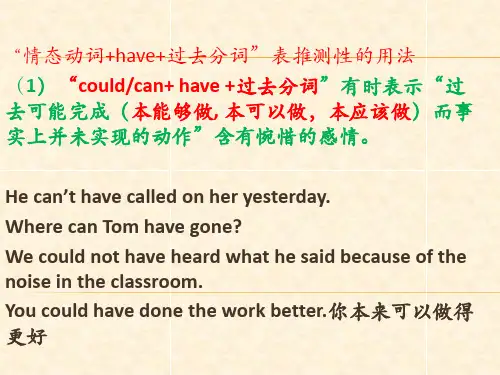
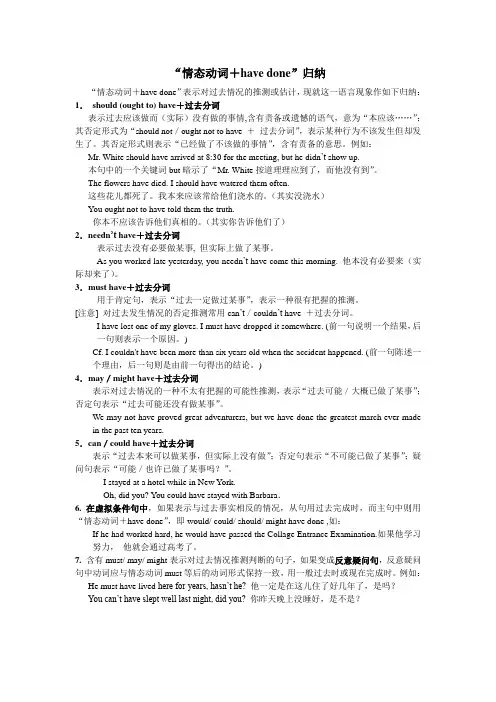
“情态动词+have done”归纳“情态动词+have done”表示对过去情况的推测或估计,现就这一语言现象作如下归纳:1.should (ought to) have+过去分词表示过去应该做而(实际)没有做的事情,含有责备或遗憾的语气,意为“本应该……”;其否定形式为“should not/ought not to have +过去分词”,表示某种行为不该发生但却发生了。
其否定形式则表示“已经做了不该做的事情”,含有责备的意思。
例如:Mr. White should have arrived at 8:30 for the meeting, but he didn’t show up.本句中的一个关键词but暗示了“Mr. White按道理理应到了,而他没有到”。
The flowers have died. I should have watered them often.这些花儿都死了。
我本来应该常给他们浇水的。
(其实没浇水)You ought not to have told them the truth.你本不应该告诉他们真相的。
(其实你告诉他们了)2.needn’t have+过去分词表示过去没有必要做某事, 但实际上做了某事。
As you worked late yesterday, you needn’t have come this morning. 他本没有必要来(实际却来了)。
3.must have+过去分词用于肯定句,表示“过去一定做过某事”,表示一种很有把握的推测。
[注意] 对过去发生情况的否定推测常用can’t/couldn’t have +过去分词。
I have lost one of my gloves. I must have dropped it somewhere. (前一句说明一个结果,后一句则表示一个原因。
)Cf. I couldn't have been more than six years old when the accident happened. (前一句陈述一个理由,后一句则是由前一句得出的结论。
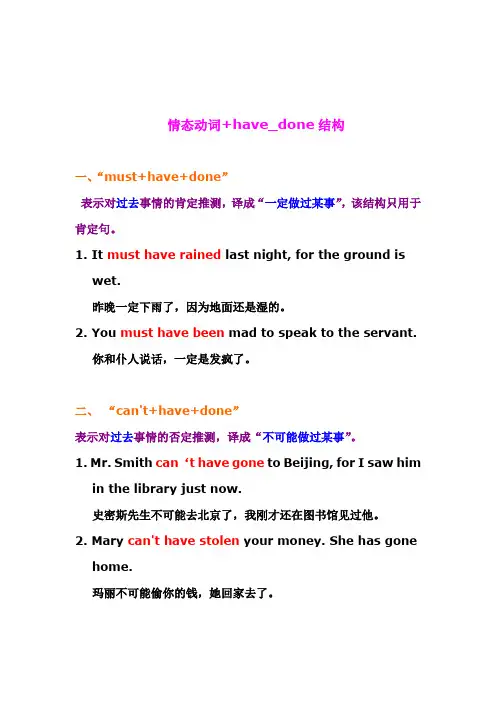
情态动词+have_done结构一、“must+have+done”表示对过去事情的肯定推测,译成“一定做过某事”,该结构只用于肯定句。
1. It must have rained last night, for the ground iswet.昨晚一定下雨了,因为地面还是湿的。
2. You must have been mad to speak to the servant.你和仆人说话,一定是发疯了。
二、“can't+have+done”表示对过去事情的否定推测,译成“不可能做过某事”。
1. Mr. Smith can‘t have gone to Beijing, for I saw himin the library just now.史密斯先生不可能去北京了,我刚才还在图书馆见过他。
2. Mary can't have stolen your money. She has gonehome.玛丽不可能偷你的钱,她回家去了。
三、“can+have+done”表示对过去行为的怀疑,用于疑问句,译成“可能做过……吗?”。
1. There is no light in the room. Can they have goneout?屋里没有灯,他们可能出去了吗?2. There is nowhere to find them. Where can theyhave gone?到处找不到他们,他们可能到什么地方去呢?四、“could+have+done”是虚拟语气,表示对过去事情的假设,译成“本来能够”做某事而没有做。
1. He could have passed the exam, but he was toocareless.本来他能够通过考试,但是他太粗心。
五、“may+have+done”表示对过去发生的事情的推测,译成“可能已经”,用于肯定句中。
——What has happened to George?——I don't know. He may have got lost.——乔治发生了什么事?——我不知道,他可能迷路了。

【高中英语】高中英语:“情态动词+have+过去分词”的用法
1.can/could/may/mighthave+donesth,表示过去,推测过去时间里可能发生过的事情。
菲利普可能/可能/可能/可能已经在卡拉奇发生了进一步的事故。
菲利普在车祸中可能/也许受了严重的伤。
2.肯定做过某事。
lindahasgonetowork,butherbicycleisstillhere.
琳达去上班了,但她的自行车还在这儿。
shemusthavegonebybus.
她一定是乘公共汽车去的。
3.should/oughttohavedonesth,本应该做某事,而事实上并没有做。
否定句表示"不该做某事而做了"。
你应该/应该放弃这个实验。
你在试验中本应该更小心的。
(实际上没有)
他不应该把衣服扔到路边。
他本不该扔掉旧衣服的。
(实际上扔了)
注意:Ougtto的语气比应该的强。
4.needn'thavedonesth,本没必要做某事却做了。
我有足够的经验,但不需要这么做。
这是天气预报。
我为了这次旅行穿得很暖和。
但是我本没必要这样做的,天气很热。
5.想过去做过某事。
iwouldliketohavereadthearticle,butiwasverybusythen.
我想读这篇文章,但当时我太忙了。
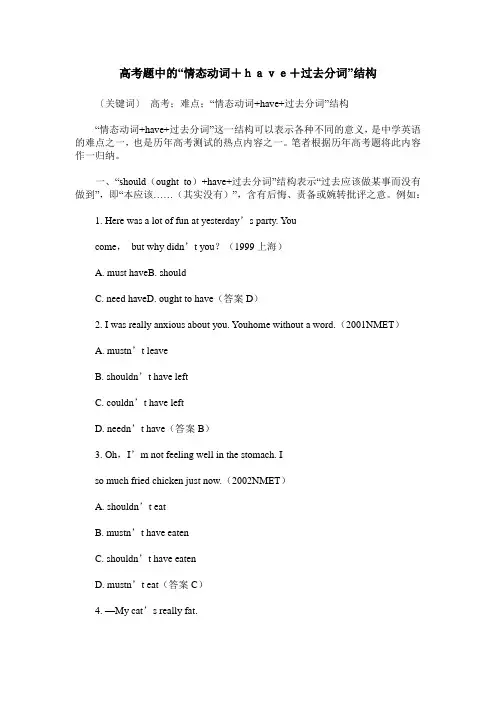
高考题中的“情态动词+have+过去分词”结构〔关键词〕高考;难点;“情态动词+have+过去分词”结构“情态动词+have+过去分词”这一结构可以表示各种不同的意义,是中学英语的难点之一,也是历年高考测试的热点内容之一。
笔者根据历年高考题将此内容作一归纳。
一、“should(ought to)+have+过去分词”结构表示“过去应该做某事而没有做到”,即“本应该……(其实没有)”,含有后悔、责备或婉转批评之意。
例如:1. Here was a lot of fun at yesterday’s party. Youcome,but why didn’t you?(1999上海)A. must haveB. shouldC. need haveD. ought to have(答案D)2. I was really anxious about you. Youhome without a word.(2001NMET)A. mustn’t leaveB. shouldn’t have leftC. couldn’t have leftD. needn’t have(答案B)3. Oh,I’m not feeling well in the stomach. Iso much fried chicken just now.(2002NMET)A. shouldn’t eatB. mustn’t have eatenC. shouldn’t have eatenD. mustn’t eat(答案C)4. —My cat’s really fat.—You have given her so much food.(2007浙江)A. wouldn’tB. couldn’tC. shouldn’tD. mustn’t(答案C)5. I told your friend how to get to the hotel,but perhaps Ihave driven her there.(2007陕西)A. couldB. mustC. mightD. should(答案D)二、“must+have+过去分词”结构表示对过去发生的事情肯定的推测或者推论,只用在肯定句,含有一定、准是的意思。
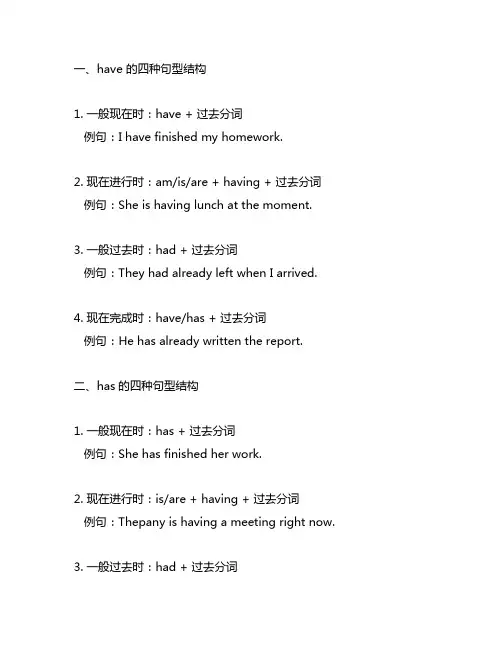
一、have 的四种句型结构1. 一般现在时:have + 过去分词例句:I have finished my homework.2. 现在进行时:am/is/are + having + 过去分词例句:She is having lunch at the moment.3. 一般过去时:had + 过去分词例句:They had already left when I arrived.4. 现在完成时:have/has + 过去分词例句:He has already written the report.二、has的四种句型结构1. 一般现在时:has + 过去分词例句:She has finished her work.2. 现在进行时:is/are + having + 过去分词例句:Thepany is having a meeting right now.3. 一般过去时:had + 过去分词例句:He has already told me what happened.4. 现在完成时:has + 过去分词例句:The project has beenpleted on time.以上是have和has的四种句型结构,根据不同的语境和时态,使用合适的句型结构能够更准确地表达所需的意思。
在学习英语语法时,逐一掌握这些句型结构,对于提高语言表达能力有着积极的作用。
希望读者能够通过本文了解have和has的使用方法,提高自己的英语水平。
对于英语学习者来说,掌握have和has的四种句型结构是基础中的基础。
在进行日常交流和写作时,使用这些句型结构能够使表达更加准确和清晰。
下面我们将深入探讨这些句型结构在实际运用中的一些细节和注意事项。
1. 一般现在时:have/has + 过去分词在一般现在时态中,have用于第一人称单数(I)、第二人称单数(you)、第二人称复数(you)、第三人称单数(he/she/it)和第三人称复数(they)的主格形式,而has则用于第三人称单数(he/she/it)。
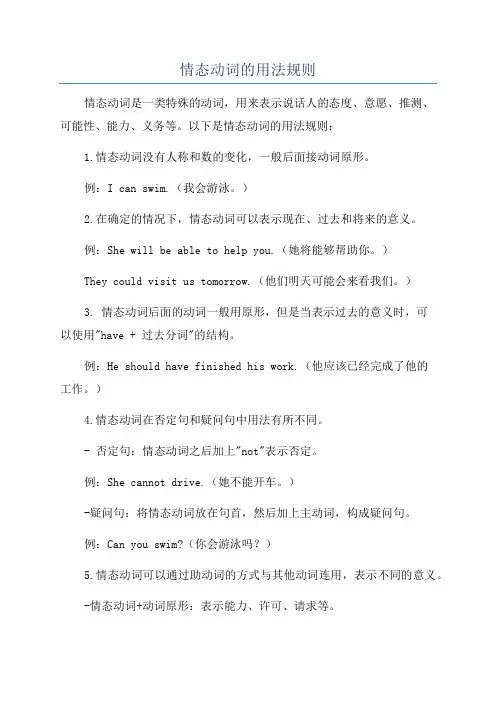
情态动词的用法规则情态动词是一类特殊的动词,用来表示说话人的态度、意愿、推测、可能性、能力、义务等。
以下是情态动词的用法规则:1.情态动词没有人称和数的变化,一般后面接动词原形。
例:I can swim.(我会游泳。
)2.在确定的情况下,情态动词可以表示现在、过去和将来的意义。
例:She will be able to help you.(她将能够帮助你。
)They could visit us tomorrow.(他们明天可能会来看我们。
)3. 情态动词后面的动词一般用原形,但是当表示过去的意义时,可以使用"have + 过去分词"的结构。
例:He should have finished his work.(他应该已经完成了他的工作。
)4.情态动词在否定句和疑问句中用法有所不同。
- 否定句:情态动词之后加上"not"表示否定。
例:She cannot drive.(她不能开车。
)-疑问句:将情态动词放在句首,然后加上主动词,构成疑问句。
例:Can you swim?(你会游泳吗?)5.情态动词可以通过助动词的方式与其他动词连用,表示不同的意义。
-情态动词+动词原形:表示能力、许可、请求等。
例:I can play the guitar.(我会弹吉他。
)May I borrow your pen?(我可以借你的笔吗?)- 情态动词 + have + 过去分词:表示推测、责备等。
例:They should have finished their homework.(他们应该已经完成了作业。
)需要注意的是,不同的情态动词有不同的意义和用法规则,因此在具体运用时需要根据相关的语境进行理解和应用。
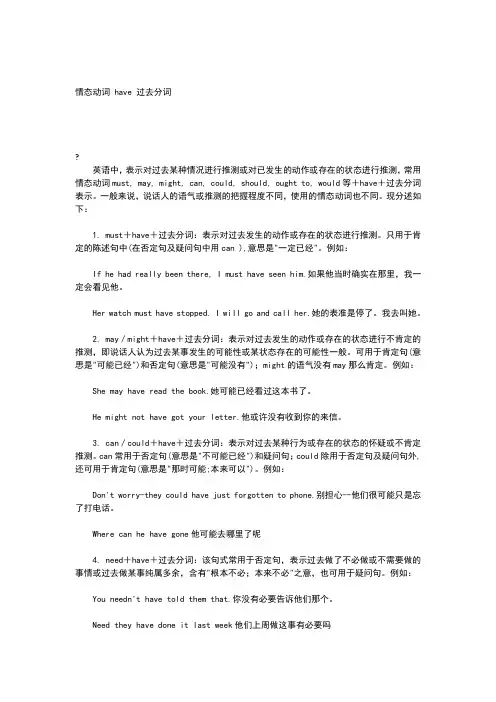
情态动词 have 过去分词?英语中,表示对过去某种情况进行推测或对已发生的动作或存在的状态进行推测,常用情态动词must, may, might, can, could, should, ought to, would等+have+过去分词表示。
一般来说,说话人的语气或推测的把握程度不同,使用的情态动词也不同。
现分述如下:1. must+have+过去分词:表示对过去发生的动作或存在的状态进行推测。
只用于肯定的陈述句中(在否定句及疑问句中用can ),意思是"一定已经"。
例如:If he had really been there, I must have seen him.如果他当时确实在那里,我一定会看见他。
Her watch must have stopped. I will go and call her.她的表准是停了。
我去叫她。
2. may/might+have+过去分词:表示对过去发生的动作或存在的状态进行不肯定的推测,即说话人认为过去某事发生的可能性或某状态存在的可能性一般。
可用于肯定句(意思是"可能已经")和否定句(意思是"可能没有");might的语气没有may那么肯定。
例如:She may have read the book.她可能已经看过这本书了。
He might not have got your letter.他或许没有收到你的来信。
3. can/could+have+过去分词:表示对过去某种行为或存在的状态的怀疑或不肯定推测。
can常用于否定句(意思是"不可能已经")和疑问句;could除用于否定句及疑问句外,还可用于肯定句(意思是"那时可能;本来可以")。
例如:Don't worry-they could have just forgotten to phone.别担心--他们很可能只是忘了打电话。
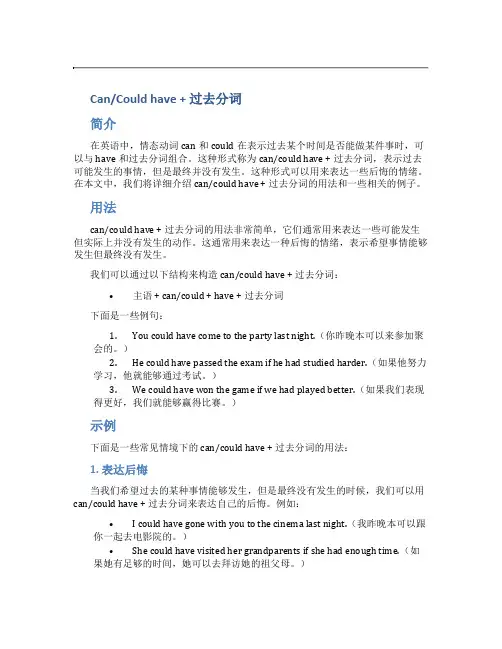
Can/Could have + 过去分词简介在英语中,情态动词can和could在表示过去某个时间是否能做某件事时,可以与have和过去分词组合。
这种形式称为can/could have + 过去分词,表示过去可能发生的事情,但是最终并没有发生。
这种形式可以用来表达一些后悔的情绪。
在本文中,我们将详细介绍can/could have + 过去分词的用法和一些相关的例子。
用法can/could have + 过去分词的用法非常简单,它们通常用来表达一些可能发生但实际上并没有发生的动作。
这通常用来表达一种后悔的情绪,表示希望事情能够发生但最终没有发生。
我们可以通过以下结构来构造can/could have + 过去分词:•主语 + can/could + have + 过去分词下面是一些例句:1.You could have come to the party last night.(你昨晚本可以来参加聚会的。
)2.He could have passed the exam if he had studied harder.(如果他努力学习,他就能够通过考试。
)3.We could have won the game if we had played better.(如果我们表现得更好,我们就能够赢得比赛。
)示例下面是一些常见情境下的can/could have + 过去分词的用法:1. 表达后悔当我们希望过去的某种事情能够发生,但是最终没有发生的时候,我们可以用can/could have + 过去分词来表达自己的后悔。
例如:•I could have gone with you to the cinema last night.(我昨晚本可以跟你一起去电影院的。
)•She could have visited her grandparents if she had enough time.(如果她有足够的时间,她可以去拜访她的祖父母。
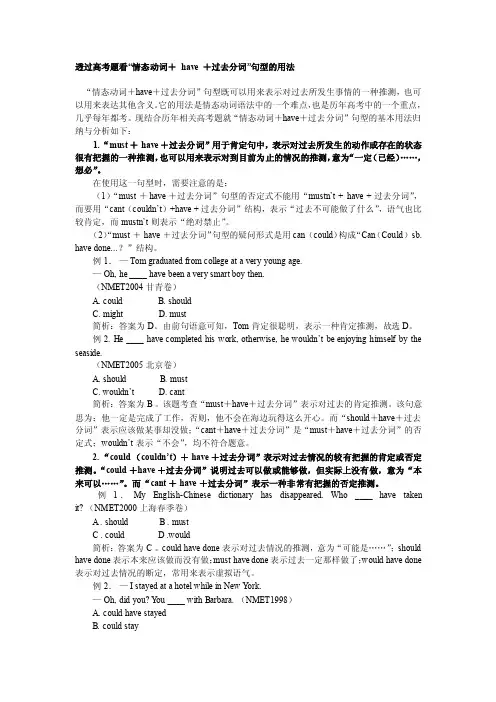
透过高考题看“情态动词+have +过去分词”句型的用法“情态动词+have+过去分词”句型既可以用来表示对过去所发生事情的一种推测,也可以用来表达其他含义。
它的用法是情态动词语法中的一个难点,也是历年高考中的一个重点,几乎每年都考。
现结合历年相关高考题就“情态动词+have+过去分词”句型的基本用法归纳与分析如下:1. “must + have +过去分词”用于肯定句中,表示对过去所发生的动作或存在的状态很有把握的一种推测,也可以用来表示对到目前为止的情况的推测,意为“一定(已经)……,想必”。
在使用这一句型时,需要注意的是:(1)“must + have +过去分词”句型的否定式不能用“mustn’t + have +过去分词”,而要用“cant(couldn’t)+have + 过去分词”结构,表示“过去不可能做了什么”,语气也比较肯定,而mustn’t则表示“绝对禁止”。
(2)“must + have +过去分词”句型的疑问形式是用can (could)构成“Can(Could) sb. have done...?”结构。
例1.— Tom graduated from college at a very young age.— Oh, he ____ have been a very smart boy then.(NMET2004甘青卷)A. couldB. shouldC. mightD. must简析:答案为D。
由前句语意可知,Tom肯定很聪明,表示一种肯定推测,故选D。
例2. He ____ have completed his work, oth erwise, he wouldn’t be enjoying himself by the seaside.(NMET2005 北京卷)A. shouldB. mustC. wouldn’tD. cant简析:答案为B 。
该题考查“must+have+过去分词”表示对过去的肯定推测。
7 情态动词+have+过去分词英语中,表示对过去某种情况进行推测或对已发生的动作或存在的状态进行推测,常用情态动词must, may, might, can, could, should, ought to, would等+have+过去分词表示。
一般来说,说话人的语气或推测的把握程度不同,使用的情态动词也不同。
现分述如下:1. must+have+过去分词:表示对过去发生的动作或存在的状态进行推测。
只用于肯定的陈述句中(在否定句及疑问句中用can ),意思是"一定已经"。
例如:If he had really been there, I must have seen him.如果他当时确实在那里,我一定会看见他。
Her watch must have stopped. I will go and call her.她的表准是停了。
我去叫她。
2. may/might+have+过去分词:表示对过去发生的动作或存在的状态进行不肯定的推测,即说话人认为过去某事发生的可能性或某状态存在的可能性一般。
可用于肯定句(意思是"可能已经")和否定句(意思是"可能没有");might的语气没有may那么肯定。
例如:She may have read the book.她可能已经看过这本书了。
He might not have got your letter.他或许没有收到你的来信。
3. can/could+have+过去分词:表示对过去某种行为或存在的状态的怀疑或不肯定推测。
can常用于否定句(意思是"不可能已经")和疑问句;could除用于否定句及疑问句外,还可用于肯定句(意思是"那时可能;本来可以")。
例如:Don't worry-they could have just forgotten to phone.别担心--他们很可能只是忘了打电话。
have单独做谓语Have的用法Have是一个常见的英语助动词,可以表示多种含义,如拥有、经历、完成等。
在句子中,have可以作为谓语动词,也可以作为情态动词或助动词。
一、have作为谓语动词1. 表示拥有当have作为谓语动词表示拥有时,它通常与名词或代词连用。
例如:- I have a car.(我有一辆车。
)- She has two children.(她有两个孩子。
)- They have a lot of money.(他们有很多钱。
)2. 表示经历当have作为谓语动词表示经历时,它通常与过去分词连用。
例如:- I have visited Paris twice.(我去过巴黎两次。
)- She has seen that movie before.(她以前看过那部电影。
)- They have experienced many difficulties.(他们经历了许多困难。
)3. 表示完成当have作为谓语动词表示完成时,它通常与过去分词连用,并且构成现在完成时态。
例如:- I have finished my homework.(我已经完成了我的家庭作业。
)- She has written three novels so far.(她到目前为止已经写了三本小说。
)- They have studied English for five years.(他们已经学习英语五年了。
)二、have作为情态动词1. 表示建议或命令当have作为情态动词表示建议或命令时,它通常与动词原形连用,并且后面跟着宾语。
例如:- You should have a rest.(你应该休息一下。
)- We must have a meeting tomorrow.(我们明天必须开会。
)- They ought to have more time to prepare.(他们应该有更多的时间来准备。
)2. 表示可能性当have作为情态动词表示可能性时,它通常与过去分词连用,并且构成现在完成时态。
have的过去式及用法例句have的过去式和过去式都是had,现在分词是having,第三人称单数是has。
have 与过去分词连用构成完成时。
英语have词性及用法v.有;持有;占有;由…组成;显示出,带有(性质、特征)aux.与过去分词连用构成完成时第三人称单数:has现在分词:having过去式:had过去分词:had英语had词性及用法aux.had 有时代替 if 用于从句句首,表示某种情况可能发生但并未发生v.有;持有;占有;由…组成;显示出,带有(性质、特征)have的过去分词和过去式have用法小结一、have作实意动词。
1.表示“有”的意思。
Look, I have wings, just like you.He had fair hair and blue eyes.〔注1〕:其否定和疑问形式变化,在美国通常用助动词do。
〔注2〕:在英国口语中常用have got代替have.Look, can’t you see I've got teeth, too.I haven't got any jewelry.2.have和一些其他名词连用,表示:(1)一种活动。
We have no classes on Sunday.(上课)they’re going to have a volleyball match.(举行比赛)Are we going to have a meeting this week?(开会)We are going to have a talk this afternoon.(听报告)(2)患病。
I have got a headache.I have a bad cold.(3)发生的情况。
I've had so many falls that I'm black and blue all over.(跌跤)(JBⅣL10) (4)生育。
情态动词对过去的推测的用法情态动词在对过去的推测时有以下几种用法:1. "must have + 过去分词":表示对过去发生的事情进行肯定的推测,认件事情过去一定发生了。
例如:He must have gone to the party last night.(他肯定昨晚去了派对。
)2. "could have + 过去分词":表示对过去发生的事情进行可能性的推测,认件事情过去可能发生了。
例如:She could have finished her homework before we arrived.(她可能在我们到达之前完成了作业。
)3. "may/might have + 过去分词":表示对过去发生的事情进行可能性较小的推测,认件事情过去可能发生了,但可能性不太高。
例如:He may have forgotten his keys at home.(他可能把钥匙忘在家里了。
)4. "should have + 过去分词":表示按理应该发生但事实未必发生的推测,表示事件过去本应该发生,但实际未必发生。
例如:They should have arrived by now, but they haven't shown up yet.(他们现在应该到了,但他们还没有出现。
5. "would have + 过去分词":表示对过去本来可能发生的情况进行推测,但实际并未发生。
常用于虚拟语气。
需要注意的是,这些情态动词的过去时形式通常为其现在时形式,否定形式通常在情态动词后加"not"。
have的用法小结一、have作为助动词构成各种完成时(包括过去、现在、将来)和完成进行时:e.g.我今天上午没见过他。
I haven‟t seen him this morning.我打电话的时候,杰克已经走了。
When I rang,Jack had already left.二、have与to一起构成情态动词have to,表示“不得不”、“必须”,它比must 更含有“客观条件使得必须如此做”的意思,可用于各种时态。
如:格林先生不得不为了生计而工作Mr.Green has to work very hard to earn a living.昨晚我只得早点离开晚会,我不大舒服。
I had to leave the party early last night.I wasn’t very well.我们明天必须起得很早。
We will have to get up very early tomorrow.我咳嗽的厉害,今天必须去诊所看看。
I shall have to go to the clinic['klinik]today for my bad cough.三、have用于“情态动词+have+过去分词”的结构,有推测、假设之意。
1.must+have+过去分词,表示对过去时间发生的动作或存在的情况的推测,表示“一定”、“准是”的意思。
一般用于肯定句。
如:e.g.你一定是误会了我的意图。
You must have mistaken my intention.She must have been very young when she got married.她结婚时一定很年轻2.can(could)+have+过去分词,常用于否定句和疑问句。
表示对过去发生事情的“可能性”。
而could较can更加表示说话人的“不肯定的”语气。
如:e.g.他会是走了吗?Can he have left already?她会把我的地址忘记了吗?Could she have forgotten my address?他当然不可能这么早到这里的。
情态动词havedone的意思及用法
情态动词'have done'是由情态动词'have'和过去分词'done'构成的,表示完成的动作或状态。
这种情态动词常用于描述已经完成或需要完成的动作,并且在口语和书面语中都被广泛使用。
在英语中,情态动词'have done'可以用于多种语境,例如:
1. 表示完成的动作
例如:I have done my homework.(我完成了我的家庭作业。
)
2. 表示对过去发生的事情的确认或否认
例如:Have you done your presentation yet?(你的演讲做好了吗?)
3. 表示对未来事件的推断
例如:By next year, we will have done a lot to protect the environment.(到明年,我们会采取很多行动来保护环境。
)
4. 表示建议或命令
例如:You should have done a better job on that project.(你应该把那个项目做得更好。
)
总的来说,情态动词'have done'可以用于许多不同的语境,使其成为英语中非常有用的一种语言工具。
当你使用这个动词时,确保你的语境清晰明确,以使你的意思更加清楚。
透过高考题看“情态动词+have +过去分词”句型的用法
“情态动词+have+过去分词”句型既可以用来表示对过去所发生事情的一种推测,也可以用来表达其他含义。
它的用法是情态动词语法中的一个难点,也是历年高考中的一个重点,几乎每年都考。
现结合历年相关高考题就“情态动词+have+过去分词”句型的基本用法归纳与分析如下:
1. “must + have +过去分词”用于肯定句中,表示对过去所发生的动作或存在的状态很有把握的一种推测,也可以用来表示对到目前为止的情况的推测,意为“一定(已经)……,想必”。
在使用这一句型时,需要注意的是:
(1)“must + have +过去分词”句型的否定式不能用“mustn’t + have +过去分词”,而要用“cant(couldn’t)+have + 过去分词”结构,表示“过去不可能做了什么”,语气也比较肯定,而mustn’t则表示“绝对禁止”。
(2)“must + have +过去分词”句型的疑问形式是用can (could)构成“Can(Could) sb. have done...?”结构。
例1.— Tom graduated from college at a very young age.
— Oh, he ____ have been a very smart boy then.
(NMET2004甘青卷)
A. could
B. should
C. might
D. must
简析:答案为D。
由前句语意可知,Tom肯定很聪明,表示一种肯定推测,故选D。
例2. He ____ have completed his work, oth erwise, he wouldn’t be enjoying himself by the seaside.
(NMET2005 北京卷)
A. should
B. must
C. wouldn’t
D. cant
简析:答案为B 。
该题考查“must+have+过去分词”表示对过去的肯定推测。
该句意思为:他一定是完成了工作,否则,他不会在海边玩得这么开心。
而“should+have+过去分词”表示应该做某事却没做;“cant+have+过去分词”是“must+have+过去分词”的否定式;wouldn’t表示“不会”,均不符合题意。
2. “could (couldn’t)+ have +过去分词”表示对过去情况的较有把握的肯定或否定推测。
“could +have +过去分词”说明过去可以做或能够做,但实际上没有做,意为“本来可以……”。
而“cant + have +过去分词”表示一种非常有把握的否定推测。
例1. My English-Chinese dictionary has disappeared. Who ____ have taken it? (NMET2000上海春季卷)
A . should
B . must
C . could
D .would
简析:答案为C 。
could have done表示对过去情况的推测,意为“可能是……”;should have done表示本来应该做而没有做;must have done表示过去一定那样做了;would have done 表示对过去情况的断定,常用来表示虚拟语气。
例2.— I stayed at a hotel while in New York.
— Oh, did you? You ____ with Barbara. (NMET1998)
A. could have stayed
B. could stay
C. would stay
D. must have stayed
简析:答案为 A 。
由对话提供的语境及其句意可知,说话人呆在纽约一家酒店事情已经发生,所以回话人说“你本来可以和Barbara住在一起”。
3. “may( might )+ have +过去分词”表示(过去)可能做了某事,意为“也许已经……,可能已经……”,突出可能性。
这种结构常用于肯定句或否定句中,不能构成疑问句式,其疑问句式常用“can( could )+ have +过去分词”结构。
例1.Sorry , I’m late. I ____ have turned off the alarm clock and gone back to sleep again.
(NMET2000京、皖春季卷)
A. might B . should
C. can
D. will
简析:答案为A 。
might have done sth.的意思是“(过去)可能做某事”,表推测。
由句子的意思可知,他可能当时把闹钟关上了,故答案为 A 。
例2. Yesterday, Jane walked away from the discussion. Otherwise, she ____ something she would regret later.
(NMET1996上海卷)
A.had said
B. said
C. might say
D. might have said
简析:答案为 D 。
根据上下文语境,该句表示一种推测。
4. “should (ought to)+have +过去分词”用于肯定句表示“过去本应该做但实际上没有做”,意思为“本来应该……的(但实际上却没有……)”,含有“责备”的意思;其否定形式要在 should或ought to后加not,构成“shouldn’t(oughtn’t to)+ have +过去分词”结构,表示“过去本不应该做而实际做了某事”,含有“责备、抱怨、后悔”之意。
例如:
例1. I was really anxious about you. You ____ home without a word.
(NMET2001 全国卷)
A.mustn’t leave
B. shouldn’t have left
C. couldn’t have left
D. needn’t leave
简析:答案为 B。
shouldn’t have done表示本来不应该做而做了,含责备意味。
句意为:我真的为你着急,你不应该一句话不说就离开了家。
例2.Oh, I’m not feeling well in the stomach. I ____ so much fried just now.(NMET2002上海春季卷)
A. shouldn’t eat
B. mustn’t have eaten
C. shouldn’t have eaten
D. mustn’t eaten
简析:答案为C 。
just now 是表示过去的时间状语,故只能在B和C两个选项中确定答案,而B为错误选项,因为mustn’t不表示判断或推测。
该题的句意为:噢,我觉得胃不舒服。
我刚才不应该吃那么多炸鸡。
例3.Mr. White ____ at 8:30 for the meeting, but he didn’t show up.
(NMET2004广西卷)
A. should have arrived
B. should arrive
C. should have had arrived
D. should be arriving
简析:答案为A。
should have done 表示过去该做某事而没做。
should do 表示现在或将来应该怎么样。
从后一句didn’t可知此题指的是过去,故答案为A 。
例4.— Ill tell Mary her new job tomorrow.
— You ____ her last week.
(NMET2004福建卷)
A. ought to tell
B. would have told
C. must tell
D. should have told
简析:答案为 D 。
根据后一句的时间状语,可排除选项A、C;选项B表示与过去事实不相符合的假设,不合题意;D表示对过去该做的事情没有做的一种责备。
故根据语境,答案选D,暗含对“你”的责备。
5. “needn’t+ have +过去分词”表示“过去没有必要做某事,但实际上却做了”,意为“本来可以不必……的(可实际上却已经……了)”。
例如: There was plenty of time. She ____.(NMET1987)
A.mustn’t have hurried
B. couldn’t have hurried
C. must not hurry
D. needn’t have hurried
简析:答案为D 。
由第一句可知“有足够的时间”,这就暗示了“she”没有必要匆忙。
再如:You needn’t have woken him up at 5 o’clock. Its too early.
你其实不必五点钟叫他,太早了。